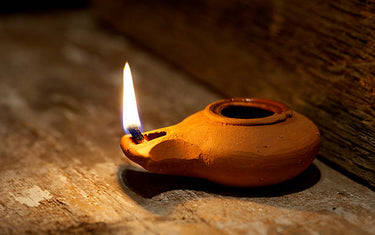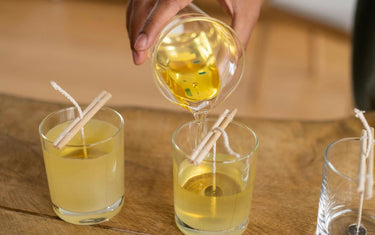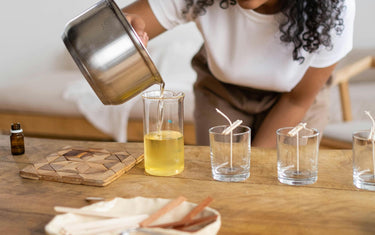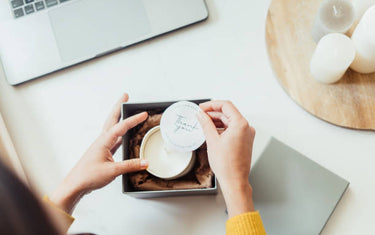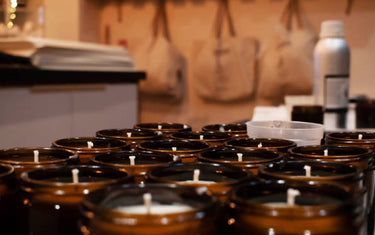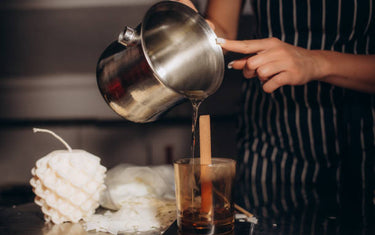4 min read / 12 August 2024 / yasmin sharp
4. Candle Making Safety and Regulations
Ensure safe candle making with essential tips on handling hot wax, proper ventilation, material storage, labelling, fire safety standards, and legal selling guidelines.
Share this post
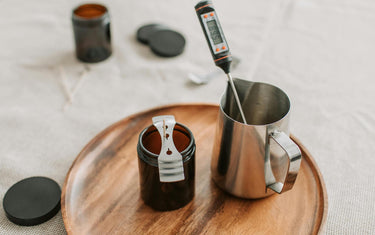
Safety Practices
1. Handling Hot Wax and Equipment
2. Ventilation & Air Circulation
Regulations
Legal Considerations for Selling Candles
Candle making is a great way to express your creativity, and it also presents the opportunity to make a little extra cash if you want to set up a business.
Whether you are making candles for personal use or to sell online, safety is paramount.
That means taking care of yourself during the production process and ensuring that anyone using your candles has the right level of protection.
We look at the basics of candle making safety and regulations, from preparation and storage of materials to candle safety labels and candle making insurance requirements.

Safety Practices
1. Handling Hot Wax and Equipment
- Wear appropriate clothing when making your candles. Long sleeved and legged clothes will protect your skin from burns, and it is also a good idea to wear shoes.
- Use safety goggles to safeguard your eyes against hot splashes and heat-proof gloves and aprons when handling equipment containing hot wax.
- To protect yourself against overheating and combustion, always use a double boiler when melting wax.
- Have a fire extinguisher close to hand and know how to use it in case of an emergency. Do not use water to put out a candle-making fire as hot wax behaves in a similar way to hot oil.
- Ensure you have easy access to a first aid kit to deal with any minor injuries that may occur.
- Check that all candle-making equipment is in good condition to withstand high temperatures. This includes things like moulds and thermometers.
- Make sure the children and pets are in a separate area when you are candle making. For children that are old enough to be involved in the process, ensure they are kept under constant supervision.
- Keep a close eye on the temperature of the wax using a thermometer. Certain fragrances and dyes require specific temperature points.
- Never leave your workspace unattended or leave wax to melt without close supervision.
- Keep your workspace clean and tidy, wiping away any cooking oil splashes that may be on the cooker, as it could create a fire hazard. Also remove any flammable materials during the candle making process.
2. Ventilation & Air Circulation
- Make sure that the space you are working in is well-ventilated. This will reduce exposure to fumes and void buildup, which can be harmful to health over extended periods.
- Opening windows or using cooker vent hoods is the best way to maintain air circulation.
- Do not inhale fragrance oils or dyes directly, as the chemical particles could cause respiratory issues.
3. Storage of Materials
- Wax, fragrance oils and dyes are best stored in a cool, dry place away from direct sunlight and heat sources. This will not only enhance safety but also allow them to last for longer.
- All candle making materials and chemicals should also be stored out of reach of children and pets.
- Good organisation makes it easier to manage your ingredients and to keep you safe. You can do this by storing materials in airtight containers with clear labelling, which will reduce the chances of contamination and degradation.

Regulations
Labelling Requirements
- If you are selling candles that contain fragrance oils or essentials oils, candle labelling requirements in the UK state that they must also feature candle warning labels.
- CLP labelling for candles contains information about ingredients, allergens, hazards and signal words. It should also include the UFI product number and your full contact details.
- Candle safety labels should be attached to the packaging that contains the candles. You can also use tags, ties or fold out labels for packaging that has an awkward shape.
- Add burning instructions to your CLP candle labels such as "Trim wick to ¼ inch before lighting" and "Keep away from drafts, children, and pets."
- Also include appropriate warning labels, such as "Burn within sight" and "Do not burn for more than 4 hours at a time."
Fire Safety Standards
- Ensure that you comply with national and local fire safety standards, which may include guidelines on the flame height and burn time.
- Your candles will also have to pass safety tests for wick stability, container integrity, and overall flame behaviour.
- Keep clear records of any safety tests and certifications for reference and compliance checks, as you may need to refer to these in the future.

Legal Considerations for Selling Candles
- Check with your local authority about selling and manufacturing candles, as there can be important differences depending on your location
- This may also require you to obtain specific permits or licences for these activities.
Insurance
- Candle making insurance is not a legal requirement. However, it can give your business some important protection in the event of a fire, illness or claim being made against you, so it is highly recommended.
- Insurance for candle makers falls under the category of “crafts” so look for this when shopping around.
- In addition to candle making insurance, employers’ liability insurance, product liability insurance, stock insurance and business equipment insurance could provide extra financial protection.
Summary
In conclusion, prioritising safety and adhering to candle safety regulations is essential for anyone involved in candle making, whether for personal enjoyment or business.
By following the guidelines outlined in this article, you can ensure a safe and compliant candle-making process.
If you're considering expanding your candle business, don't forget to sign up for Nikura's wholesale program to access quality materials and support tailored to your needs.

